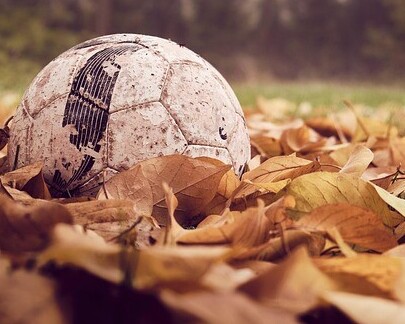 Soccer is a sport that’s fun to play, easy to pick up, and great for staying active. But a lot of folks think you need a big field or a team to really get better. Here’s the truth: you can take your soccer skills up a notch right at home, even if you just have a small backyard, a garage, or a bit of open space in your living room.
Soccer is a sport that’s fun to play, easy to pick up, and great for staying active. But a lot of folks think you need a big field or a team to really get better. Here’s the truth: you can take your soccer skills up a notch right at home, even if you just have a small backyard, a garage, or a bit of open space in your living room.
If you want more control on the field, sharper footwork, or just want to pass the time in a healthy way, home training comes in pretty handy. The best part? You don’t need fancy equipment or loads of space. With a soccer ball, a few simple targets, and a little commitment, you can see awesome improvements.
I’ve pulled together a list of top soccer skills you can practice at home, along with clear steps and practical tips for getting the most out of your solo sessions. By sticking with these drills, you’ll notice quick results in your first touch, footwork, and confidence. These exercises are not only useful for beginners, but also help advanced players stay on top of their game between team practices. No matter where you are in your soccer adventure, these drills keep you engaged and growing.
www.wealthyaffiliate.com?a_aid=a12e49d9
1. Ball Control: Mastering First Touch
Great ball control is the foundation of everything else in soccer. Developing a soft and precise first touch helps you keep the ball close, whether you’re getting a pass, catching a rebound off the wall, or stopping a fast moving ball on the pitch. Practicing your first touch at home not only increases confidence, but also helps you react more quickly during the pressure of real games.
How to Practice at Home:
- Wall Passing: Kick the ball gently against a wall and cushion it with your foot as it returns. Use both your dominant and nondominant feet to develop ambidexterity and balance.
- Air Touches: Toss the ball into the air and use different parts of your body—feet, thighs, or chest—to control it as softly as possible. Focus on touching the ball so it drops right in front of you, ready for your next move.
Keep the ball close and challenge yourself with one-touch passes or adding a movement, such as sidesteps or turns, after each touch. Over time, incorporate dribbling away from the wall or juggling after each touch to mix things up. These variations boost your reaction speed and coordination.
2. Dribbling Skills: Quick Feet for Tight Spaces
Being able to weave through defenders is super important, especially in intense games. Practicing at home using cones or even shoes as markers helps build nimble footwork and fast direction changes. Home dribbling is great for fine-tuning your speed, ball control, and ability to keep your head up while moving.
Home Dribbling Drills:
- Slalom Dribble: Line up objects a few feet apart and weave through them as quickly as you can, keeping the ball close to your feet. Start slow, then gradually increase your speed as you get more comfortable.
- Figure 8s: Place two markers a couple of feet apart and dribble the ball in a figure 8 pattern around them. Go as quickly as possible without losing control and try changing directions every few runs.
- Fast Feet Taps: Tap the top of the ball alternately with each foot, focusing on quick, light touches. This wakes up your coordination and helps you develop faster foot speed.
Set a timer and aim to beat your previous speed each session. You can add more markers or shrink the spaces for extra challenge. These drills translate to better dribbling under pressure in real matches, helping you move away from defenders and control the pace of play.
3. Passing Accuracy: Perfect Timing and Placement

Passing isn’t just about moving the ball away from you. It’s about timing, accuracy, and making the game play out the way you want. Practicing passing at home sharpens your ability to hit your target even without anyone else around. Good home passing habits make you a more dependable player on the pitch.
Solo Passing Drills:
- Wall Passing with Targets: Mark targets on your wall with tape or chalk and aim for them with each pass. Try different distances and pass with both feet to keep things balanced.
- Passing Gates: Set up two objects a couple feet apart as a gate and try to pass the ball through the gap from various angles. Move farther back as you get better to increase the challenge.
- One Touch Passes: Hit the ball against the wall and return it with just one touch. This builds both your touch speed and accuracy, and helps you think faster on your feet.
It helps to keep score and try to beat your record each week to motivate yourself. Try mixing in left and right foot passes so you stay balanced as a player. If you have a friend or family member around, turn drills into mini contests for extra motivation.
4. Juggling: Ball Control in the Air
Juggling is one of those classic soccer drills that seems simple, but it’s a real challenge. It boosts your touch, focus, and body coordination, and all you need is a little space. Not only does juggling look next-level cool, but it also helps with your balance and reaction speed in game situations where the ball isn’t always at your feet.
Juggling Tips:
- Start by juggling once or twice then let the ball bounce, just to get the feel for the rhythm.
- Gradually increase your target numbers. Set small goals, like five juggles, then ten, then more each week.
- Use both feet, your thighs, and eventually your head as you feel more confident. Practicing juggling with different body parts gets you ready for real matches.
Even a few minutes of juggling every day adds up to much better control over time. If you get frustrated, just remember that progress happens bit by bit. Patience and persistence are key here. Try switching up the type of ball or adding a small challenge, like keeping your eyes looking forward or juggling while moving sideways.
5. Shooting Technique: Power and Precision

Shooting is about more than just blasting the ball as hard as you can. Good technique helps you place shots where you want and generates the right amount of force with less effort. Practicing your shooting at home grows your confidence, especially if you find a way to hit a target safely.
Home Shooting Drills:
- Target Shooting: Use bins, cones, or any safe object as targets. Try to knock them over, or land the ball right next to them from various distances. Change targets or set up multiple at once to make it more fun.
- Instep Kicks: Lean over the ball, lock your ankle, and strike with your laces for power. Practice with both feet for balance in your game and focus on where you plant your nonkicking foot for better aim.
If you have soft netting or a wall, use it to absorb the shot and save your neighbors from flying soccer balls. Always focus on where the ball lands more than how hard you hit it. Building good habits here pays off with more goals when you return to team play. Tracking your shot accuracy over time gives you an easy way to see your growth.
6. Agility and Balance: Move Like a Pro
Soccer calls for quick changes in direction, sudden stops, and a lot of balance under pressure. Strengthening these areas at home can make all your skills sharper and help you avoid injuries. Regular agility and balance work gives you a smoother feel on the ball and also helps with reaction time.
Easy Home Agility Workouts:
- Ladder Drills: If you don’t have a ladder, tape one on the ground. Run through it using fast feet and mix up the pattern: forward, sideways, crisscross, or hop through the spaces for added challenge.
- Single Leg Stands: Stand on one foot and try kicking a ball lightly. When you master this, try closing your eyes—it makes balance way harder and brings your core muscles into play.
- Side Shuffles: Using a few markers, shuffle side to side as quickly as possible, always keeping your knees bent and your head up. These quick movements simulate changing direction to track down the ball.
Working on agility keeps you quick, sharp, and less likely to get injured when you’re back on the pitch. Mix speed drills with balance for the best home training. As you improve, try adding in a ball for combination moves—like dribbling while you shuffle—which gives your coordination a real boost.
7. Soccer Brain: Awareness and Creativity
Top players train their brains as much as their feet. Building spatial awareness, quick thinking, and creativity gives you a big edge, and you can work on these anywhere. A sharp soccer mind lets you read the game and respond faster than the competition.
How to Build Soccer IQ at Home:
- Watch professional games and notice how players position themselves and make quick decisions. Take notes or draw out positions and try to copy them in your backyard.
- Try to picture different plays or moves, then practice them in your space. Visualizing what you want to do makes your skills stronger and your responses faster.
- Set personal challenges—like dribbling in tighter circles each day or passing with different surfaces of your foot. Using your imagination keeps things interesting and helps your creativity grow.
Combining skill drills with mental exercises sharpens your whole approach to the game. The more you use your imagination and keep learning from the pros, the better you’ll get at making smart plays under pressure.
